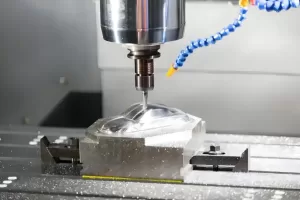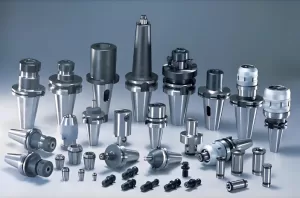February 15, 2025
Application of CNC machine tools in precision machining of aviation components
CNC Machine Tools: Revolutionizing Precision Manufacturing in the Aviation Industry
1. The rapid growth of the aviation industry has increased the demand for precision and complexity in parts and components.
CNC machine tools (Numerical Control Machine Tools) have become essential for meeting these requirements. These machines automate machining tasks, ensuring high precision, consistency, and efficiency. This article explores the technical principles of CNC machine tools, their characteristics, and their role in aviation manufacturing. It highlights how CNC machine tools help achieve the precision and efficiency needed for producing aviation parts.
2. Technical Principles of CNC Machine Tools
CNC machine tools are automated devices that use pre-programmed control systems to execute complex machining tasks. The system processes control codes, decodes them, and directs machine movements for part processing. The control system is the core of CNC machine tools, consisting of both hardware and software components.

Hardware: includes components like computers, input/output devices, and drive mechanisms.
Software: includes the operating system, programming language, and application software. The control system processes instructions, analyzes them, and directs machine components to move accurately.
The servo system powers the machine tool, adjusting movement speed and position according to control instructions.
Feedback Devices monitor the machine’s movements in real-time, feeding information back to the control system for closed-loop control. This improves machining accuracy.
The machine tool’s mechanical structure, including the bed, spindle, table, and guideways, directly affects machining accuracy. Modern CNC machine tools have rigid structural designs to maintain stability during high-speed, high-precision operations.
3. Technical Characteristics of CNC Machine Tools
CNC machine tools are known for their efficiency, precision, and flexibility. Below are some key characteristics:
3.1 High Accuracy and Repeatability
CNC machine tools provide micron- or nanometer-level precision, crucial for producing high-quality parts. Thanks to stable program control, CNC machines maintain consistency across multiple machining cycles. This ensures high-quality production and improved efficiency.
3.2 High Level of Automation
CNC machine tools automate the entire process, including clamping, machining, and testing. This reduces manual intervention, lowers labor intensity, and minimizes human error. The automation improves production efficiency, stability, and consistency, ultimately enhancing part quality.
3.3 Flexibility
CNC machine tools offer unmatched flexibility, easily adapting to different machining programs and tools. They are well-suited for multi-species, small-batch production, quickly responding to changing market demands. CNC systems can rapidly switch between production strategies to meet customer requirements.
3.4 High Processing Capacity
CNC machines often feature multi-axis capabilities, enabling them to process complex surfaces and three-dimensional contours. Their high-speed cutting ability enhances machining efficiency, making CNC machines ideal for handling a wide range of complex tasks.
4. CNC Machine Tools in Precision Machining of Aviation Parts
4.1 High-Speed Cutting Technology
High-speed cutting involves increasing the cutting speed, spindle speed, and feed rate to efficiently remove material. For aluminum alloys, high-speed cutting can achieve cutting speeds of 2,000-5,000 m/min, spindle speeds of 10,000-40,000 rpm, and feed speeds of 2-20 m/min. This technology reduces machining time, enhances productivity, and improves material removal rates (30-40 kg/hr).

High-speed cutting lowers cutting temperatures, minimizing thermal deformation and improving machining accuracy. It reduces tool wear and extends tool life. High-speed cutting is widely used in manufacturing aerospace components like engine blades and structural parts, ensuring precise machining and maintaining aerodynamic performance and structural strength.
4.2 Flexible Reinforcement Techniques
Flexible machining integrates software programming and automation to process different workpiece shapes, sizes, and materials. It adapts quickly to product design changes, reducing lead times and improving equipment utilization.
For example, high-performance five-axis CNC machines can handle the entire machining process—from roughing to finishing—for aero-engine blades. Integrating programming and machine operations reduces clamping times and improves machining accuracy. High-speed cutting optimizes material usage by reducing waste and lowering production costs.
CNC systems can also monitor machining parameters like cutting force and temperature, ensuring machining quality stability.
4.3 CAD/CAM Systems
CNC machines are controlled by pre-programmed computer commands. CAD (Computer-Aided Design) and CAM (Computer-Aided Manufacturing) systems work together to streamline design and manufacturing. CAD designs 3D models, and CAM translates these models into CNC code for machine operations.
For example, in aerospace turbine blade production, CAD software designs an accurate 3D model of the blade. CAM software converts the model into G-code, guiding the CNC machine in the machining process. This integration improves accuracy, reduces human error, and ensures parts meet aerospace industry standards.
The advantages of CAD/CAM systems include improved precision, reduced errors, faster cycle times, and the ability to adjust to design changes quickly.
4.4 DNC Technology
DNC (Distributed Numerical Control) connects multiple CNC machines to a central computer system, enabling remote program transmission, storage, and editing. DNC technology speeds up program transmission, reducing errors and improving program accuracy in aerospace manufacturing.
DNC systems allow real-time monitoring of machine performance, including machining progress and equipment status. Production managers can optimize scheduling and improve equipment utilization, leading to better overall production efficiency.
DNC technology integrates with quality inspection systems to monitor processing quality in real time. It detects deviations early, improving accuracy and ensuring parts meet precision requirements.
5. Conclusion
CNC machine tools play a key role in precision machining for the aviation industry. Their automation, intelligence, and precision help produce complex, high-accuracy parts while improving efficiency and reducing human error. Advanced technologies like high-speed cutting, flexible machining, CAD/CAM integration, and DNC systems will continue to drive the development of the aviation manufacturing industry. By enhancing precision and reliability, CNC machine tools support the growth and innovation of the aerospace sector, helping to achieve the industry’s future goals.